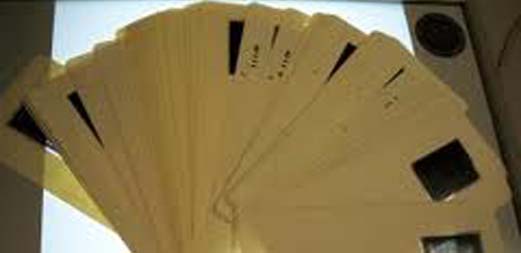Aperture Cards
 Aperture Card is a standard Hollerith encoded IBM-style punch card that acts as a transport for a 35mm transparency. Typically, aperture cards are used to store engineering drawings, many organisation in the engineering industry have years of their technical drawings archive held on aperture cards. The microfilm tehnology is around for few decades and offered a secured and organised storage to their drawings.
Aperture Card is a standard Hollerith encoded IBM-style punch card that acts as a transport for a 35mm transparency. Typically, aperture cards are used to store engineering drawings, many organisation in the engineering industry have years of their technical drawings archive held on aperture cards. The microfilm tehnology is around for few decades and offered a secured and organised storage to their drawings.
However, there are some drawbacks to perserving drawing on aperture cards, for example, the aperture card which contain the drawing can only be used by one person at one given time, it is not such a secure storage medium as if the aperture is lost or damaged, the actual drawing is lost forever. It is also a very time consuming process to view the drawing from the aperture card microfilm as the aperture card viewer needs to be set and fouced each time. Finally aperture card film readers are not very reliable and often break, which increases the maintainance cost.
In the past decade technology has rapidly improved the way organisations store, archive and access their drawings. It has become imperative for businesses to look into the current methods of archiving and accessing data not only to improve their current storage and access medium but also to save cost and better managment of their drawings and associated documents.
Electronic storage and access have been around for a decade now and organisations are being forced to implement the new technology by its huge benefits. There are many advantages for the conversion of the aperture cards into electronic files. Two of the main advantages of aperture card scanning and conversion to electronic format that are not avaliable with old traditional aperture cards archiving are.
- instant access to aperture cards scanned drawings
- the scanned aperture cards can be shared across the business network simultaneously.
Aperture Cards Scanning
Our aperture card scanning bureau are able to scan engineering and technical drawings which are maintained on aperture cards at a high resolution creating a quality image and capturing the intricate detail from the drawing. After the initial raw scanning process, all aperture card scanned images are put through our image processing which enhances the image quality for poor and aged drawings and cards, as well optimise for the file size for shared access.
Aperture Cards Scanning Images Samples for Review
Aperture Cards samples are submitted for review and approval by our clients. Prior to the start of the project, rules are established for production scanning work. The scanned aperture card drawing image standards are then used for comparison purposes to assure that quality and production standards are being met throughout the scanning and conversion process.
Aperture Card Indexing
Once the aperture card scanning process is complete, aperture cards are then indexed and an electronic library is created by:
- Drawing Number / Part Number
- Issue Number / Date
- Drawing Description
- Client Name
Storage Media
On completion of the scanning and indexing process, our strict Quality Assurance (QA) staff check each aperture card image prior to its release. Once released from the QA section, aperture cards are stored onto CDs. Our clients can copy the CD onto their local network for shared access.
Free Viewing Software
Our aperture card scanning bureau also supply our FREE Image retrieval software as a part of our aperture cards scanning service to our clients on a CD format. Once the CD is inserted into your PC, a small search program will appear on your screen, all you need to do is simply type in the drawing no. or title you require. Within seconds the drawing is displayed on your screen. If you wish, the drawing can be printed, plotted, viewed or even e-mailed.
If you have an archive of aperture cards and would like to convert your aperture cards to electronic computer files so you can easily access them, please contact us:

